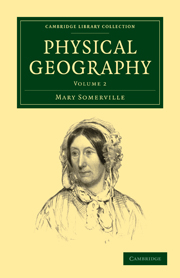Summary
In the present state of the globe a third part of its surface only is occupied by land, and probably not more than a fourth part of that is inhabited by man, but animals and vegetables have a wider range. The greater part of the land is clothed with vegetation and inhabited by quadrupeds, the air is peopled with birds and insects, and the sea teems with living creatures and plants. These organized beings are not scattered promiscuously, but all classes of them have been originally placed in regions suited to their respective wants. Many single animals and plants are indigenous only in determinate spots, while a thousand others might have supported them as well, and to many of which they have been transported by man.
The atmosphere supplies the vegetable creation with the principal part of its food; plants extract inorganic substances from the ground, which are indispensable to bring them to maturity.
The black or brown mould, which is so abundant, is the produce of decayed vegetables. When the autumnal leaves, the spoil of the summer, fall to the ground, and their vitality is gone, they enter into combination with the oxygen of the atmosphere, and convert it into an equal volume of carbonic acid gas, which consequently exists abundantly in every good soil, and is the most important part of the food of vegetables.
- Type
- Chapter
- Information
- Physical Geography , pp. 42 - 62Publisher: Cambridge University PressPrint publication year: 2009First published in: 1848



